
18:05, 28-Feb-2019
Full Episode - China’s Targeted Poverty Alleviation Campaign

China has made unprecedented achievements in poverty alleviation: in the past five years, after President Xi proposed the concept of “targeted” poverty alleviation in 2013, about 10 to 14 million people per year have been brought out of extreme poverty. Targeted poverty alleviation means decisions need to be made on practical and individualized situations, including standardized definitions of poverty, identification criteria of poor people, and customized plans and programs to bring them out of poverty. In addition, Xi proposed six kinds of “precisions”, including precision in identifying the real poor and in tailoring aid projects to help the poor according to their needs, to reinforce the goal of eliminating all extreme poverty. But above all, it is the clear and demarcated responsibilities and coordinate actions of different levels of CPC departments that guarantee the fulfillment of the goal. However, as it might be too abstract to comprehend poverty alleviation work in a macro-perspective, we should focus on an individual situations to see how the mechanism works and understand how poverty alleviation, as a cornerstone of the domestic agenda, changes the lives of ordinary people.

People from poor households listen in a planting technology training class, a targeted poverty alleviation program in Haikou, Hainan Province. /VCG Photo
People from poor households listen in a planting technology training class, a targeted poverty alleviation program in Haikou, Hainan Province. /VCG Photo
From southern Hainan Province to northwestern Gansu Province, all levels of Party secretaries, including central, provincial, county, city, village, work to alleviate poverty. An example of Communist Party members and cadres who are fighting poverty at the grassroots, Huang Haijun, who must live apart from his family for two years, is striving to raise the living standard of villagers in Lingmen Village. As a result of his and his colleagues’ hard work, a democratic and effective poverty identification and evaluation system has been put into operation. Impoverished villagers are also instructed how to increase their incomes. His achievements not only express the Party’s people-centered principle but also his own sense of satisfaction. In addition to the Party’s efforts, Chinese people living below the poverty line also take an active part in improving their lives. For example, although Zhou Jing’s family is poor, they never stop supporting their daughters’ education. They are convinced that sticking to one of President Xi Jinping’s five poverty alleviation strategies—here, education—their destiny can be changed. To them, education is more hope than burden. To China, poverty alleviation broadly is a long-term task; however, the first target, a moderately prosperous society by 2020, where extreme poverty is eliminated, is well within reach.
SITEMAP
Copyright © 2018 CGTN. Beijing ICP prepared NO.16065310-3
Copyright © 2018 CGTN. Beijing ICP prepared NO.16065310-3